Related Research Articles
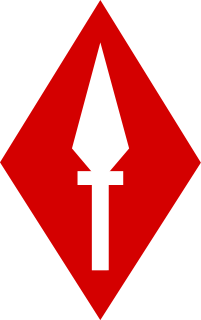
I Corps was an army corps in existence as an active formation in the British Army for most of the 80 years from its creation in the First World War until the end of the Cold War, longer than any other corps. It had a short-lived precursor during the Waterloo Campaign.

The 1st Division, formerly known as the 1st Armoured Division, is a division of the British Army. It has recently returned home from being stationed in Germany. Originally formed in November 1937 as the Mobile Division, it saw extensive service during the Second World War and was disbanded afterwards; reconstituted in 1976, it remains in service. It should not be confused with the 1st Infantry Division.

The 56th (London) Infantry Division was a Territorial Army infantry division of the British Army, which served under several different titles and designations. The division served in the trenches of the Western Front during the First World War. Demobilised after the war, the division was reformed in 1920 and saw active service again in the Second World War in Tunisia and Italy. The division was again disbanded in 1946 and reformed first as an armoured formation and then as an infantry division before final disbandment in 1961.

The 8th Armoured Division was an armoured division of the British Army during the Second World War. It was deployed to Egypt in June 1942 but never operated as a complete formation and was disbanded in January the following year.
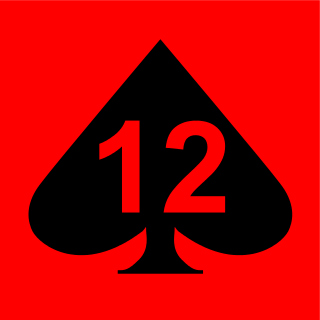
The 12th Armoured Infantry Brigade, formerly the 12th Mechanized Brigade, is a regular brigade of the British Army which has been in almost continuous existence since 1899 and now forms part of 3rd Division.

The 49th Infantry Brigade, also known as 49 (East) Brigade, was a brigade of the British Army.

The 31st Signal Regiment was a territorial communications regiment of the British Army's Royal Corps of Signals. The regiment first formed following the creation of the Territorial and Army Volunteer Reserve in 1967 after the 1966 Defence White Paper. After seeing limited reserve support during the Cold War, the regiment was disbanded in 2010 following the initial Army 2020 reform.

The 11th Signal Brigade and Headquarters West Midlands is a signal formation of the British Army's 3rd UK Division. Its headquarters is located at Venning Barracks, in Donnington in Shropshire.

The Middlesex Yeomanry was a volunteer cavalry regiment of the British Army originally raised in 1797. It saw mounted and dismounted action in the Second Boer War and in World War I at Gallipoli, Salonika and in Palestine, where one of its officers won a Victoria Cross at the Battle of Buqqar Ridge and the regiment rode into Damascus with 'Lawrence of Arabia'. Between the world wars the regiment was converted to the signals role and it provided communications for armoured formations in World War II, including service in minor operations in Iraq, Palestine, Syria and Iran, as well as the Western Desert, Italian and North-West European campaigns. It continued in the postwar Territorial Army and its lineage is maintained today by 31 Signal Squadron, Royal Corps of Signals, which forms part of the Army Reserve.

The Northern Army Group (NORTHAG) was a NATO military formation comprising four Western European Army Corps, during the Cold War as part of NATO's forward defence in the Federal Republic of Germany.
Land Command was a military command and part of the structure of the British Army from 1995 to 2008. Its headquarters was at Erskine Barracks, at Fugglestone St Peter, some four kilometres northwest of Salisbury in Wiltshire.

The 1st Signal Brigade, formally known as the 1st Signal Group was a communications command of the British Army. The group was first formed in 1968 as a result of the 1966 Defence White Paper which expanded support for NATO and the British Army of the Rhine. In 1987 the group was disbanded and merged into the 2nd Signal Brigade.
London District Signals was a headquarters signal unit of the Royal Engineers (RE) and later Royal Corps of Signals in Britain's Territorial Army from 1908. It served with a corps headquarters at Gallipoli and on the Western Front during World War I, and later became an air defence signal unit during World War II. Its successor unit continues in the Army Reserve today.

The British Army's 1st Artillery Brigade, formerly 1st Artillery Brigade and Headquarters South West, is a formation under 3rd UK Division that has control over close support artillery units within the British Army and was the Regional Point of Command (RPoC) for British Army units in the South West Region.
The following is a hierarchical outline for the structure of the British Army in 1989. The most authoritative source for this type of information available is Ministry of Defence, Master Order of Battle, and United Kingdom Land Forces, HQ UKLF, UKLF ORBAT Review Action Plan, HQ UKLF, 1990.
Army 2020 was announced in parliament in November that year which would see a massive re-organisation of the British Army. After many lessons and Operation Herrick, the higher command sought to make an army that was 'prepared for the future'.
1 Signal Regiment is a military communications regiment of the British Army. The regiment is now part of the 11th Signal Brigade.
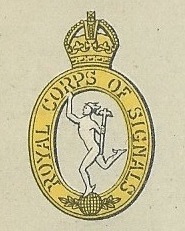
1st Armoured Division Signals was a unit of Britain's Royal Corps of Signals providing communications for the 1st Armoured Division during World War II. It was present during the Battle of France, the Western Desert Campaign, including the battles of Gazala and Alamein, the Tunisian Campaign, and the Battle of Coriano during the Italian Campaign.
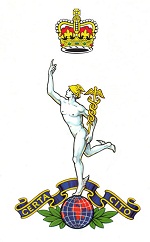
The City of London Signals was a Territorial Army unit of the British Army's Royal Corps of Signals. It had its origins in a signal company of the Royal Engineers formed in 1908 and during World War II it provided the divisional signals for the 56th (London) Division and its duplicates as well as communications for the Royal Air Force in the Middle East. Its successors continued in the postwar Territorial Army and Army Reserve until 2016.
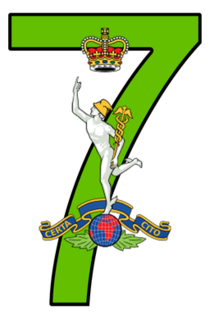
7 Signal Group is a military communications formation of the British Army's Royal Corps of Signals, currently subordinated to 11th Signal Brigade and Headquarters West Midlands. The group oversees the close support signal units of the corps tasked with supporting 3 (UK) Division.
References
Citations
- 1 2 Watson 2005, p. 39.
- 1 2 3 4 5 Watson 2005, p. 13.
- 1 2 3 4 5 6 Watson 2005, p. 31.
- 1 2 Watson 2005, p. 55.
- ↑ Watson 2005, p. 53.
- ↑ Watson 2005, p. 41.
- ↑ Watson 2005, p. 54.
- ↑ Watson 2005, p. 34.
- ↑ Watson 2005, p. 15.
- ↑ Watson 2005, p. 36.
- 1 2 3 4 5 6 7 Watson 2005, p. 51.
- 1 2 Watson 2005, p. 65.
- 1 2 3 4 5 6 7 8 Watson 2005, p. 140.
- ↑ Watson 2005, p. 87.
- ↑ Watson 2005, p. 103.
- ↑ Watson 2005, p. 57.
- 1 2 Watson 2005, p. 59.
- ↑ Watson 2005, p. 88.
- ↑ Watson 2005, p. 90.
- ↑ Watson 2005, p. 61.
- ↑ Watson 2005, p. 62.
- 1 2 3 Watson 2005, p. 60.
- ↑ Watson 2005, p. 135.
- ↑ Watson 2005, p. 110.
- ↑ Watson 2005, p. 91.
- ↑ Watson 2005, p. 58.
- ↑ Watson 2005, p. 52.
- ↑ Watson 2005, p. 142.
- ↑ Watson 2005, p. 113.
Bibliography
- Watson, G; Rinaldi, R (2005). The British Army in Germany: An Organizational History 1947-2004. Tiger Lily Publications. ISBN 0-9720296-9-9.